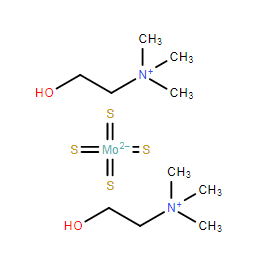| Cas No.: | 649749-10-0 |
| Chemical Name: | 2-hydroxy-N,N,N-trimethyl-ethanaminium, tetrathioxomolybdate |
| Synonyms: | Choline tetrathiomolybdate;WTX-101,WTX 101,WTX101 |
| SMILES: | C[N+](C)(C)CCO.C[N+](C)(C)CCO.S=[Mo-2](=S)(=S)=S |
| Formula: | C10H28MoN2O2S4 |
| M.Wt: | 432.542 |
| Sotrage: | 2 years -20°C Powder, 2 weeks 4°C in DMSO, 6 months -80°C in DMSO |
| Description: | ATN-224 is an oral Cu2+/Zn2+-superoxide dismutase 1 (SOD1) inhibitor. ATN-224 inhibits SOD1 activity in endothelial cells, an effect that is dose dependent with an IC50 of 17.5±3.7 nM. |
| In Vivo: | ATN-224 also significantly (P<0.05) inhibits angiogenesis in the Matrigel plug model in mice either when added directly to the plug or when given by oral gavage. Inhibition of angiogenesis when ATN-224 is given by oral gavage occurred before there is measurable depletion of copper in either plasma or copper from the Matrigel plug. This result shows that ATN-224 inhibits angiogenesis independently of copper depletion[1]. |
| In Vitro: | ATN-224 has a specific and high affinity for copper ions (108 mol/L-1) and shows no binding to calcium, iron, magnesium, zinc, or manganese ions at concentrations up to 1 mM as determined by isothermal titration calorimetry. ATN-224 inhibits the proliferation of both HUVEC (IC50=1.4±0.3 μM; n=5). ATN-224 is also able to inhibit the activity of purified bovine SOD1 with an IC50 of 0.33±0.03 μM after 24 hours of incubation. The SOD1 inhibition by ATN-224 is time dependent, reaching maximal inhibition at ~16 hours. ATN-224 seems to inhibit SOD1 by depleting the enzyme of copper. ATN-224 is able to inhibit SOD1 activity in endothelial cells, an effect that is dose dependent with an IC50 of 17.5±3.7 nM. ATN-224 inhibits FGF-2-induced ERK1/2 phosphorylation in a dose-dependent and time-dependent manner with an IC50 between 1.25 and 2.5 μM, consistent with the IC50 for the inhibition of proliferation[1]. ATN-224 is an orally-available inorganic small molecule that inhibits the copper/zinc-dependent enzyme, superoxide dismutase 1 (Cu/Zn-SOD1), in endothelial and tumor cells[2]. |

 To enhance service speed and avoid tariff delays, we've opened a US warehouse. All US orders ship directly from our US facility.
To enhance service speed and avoid tariff delays, we've opened a US warehouse. All US orders ship directly from our US facility.




















